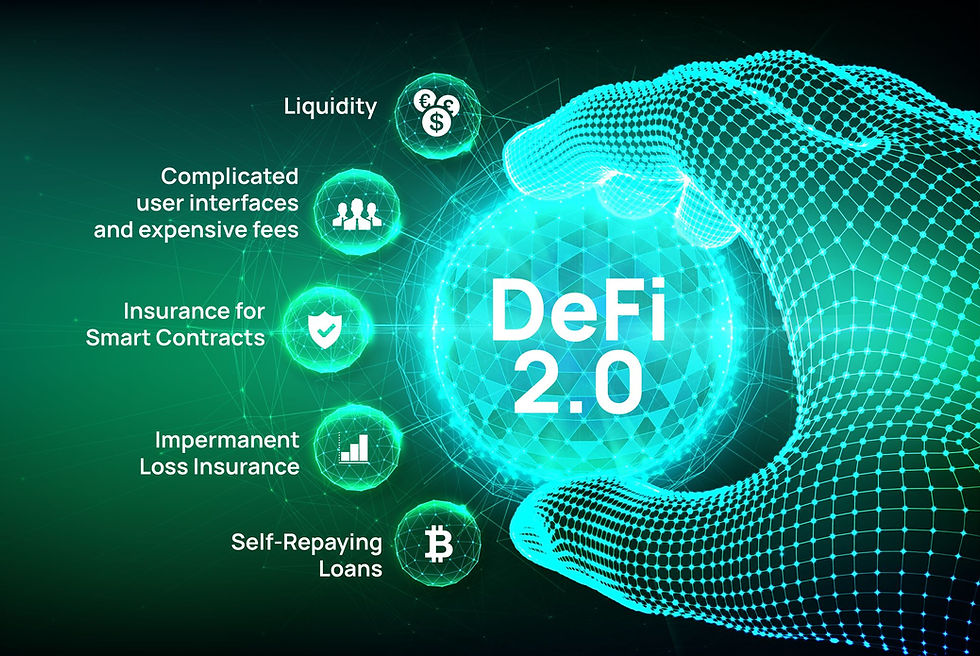DeFi 2.0 in 2025: Which Protocols Will Deliver Real Yield?
- Bitcoinsguide.org

- Aug 6
- 3 min read
The shift from unsustainable incentives to real user-driven income streams in decentralized finance
Since the explosive growth of DeFi in 2020–2021, the space has been plagued by unsustainable yield farming, inflationary token emissions, and fleeting hype cycles.
By 2025, decentralized finance has matured, forcing protocols to focus on real yield—income generated from genuine economic activity rather than token giveaways.
This post analyzes the key drivers behind DeFi 2.0’s evolution, identifies protocols pioneering sustainable returns, and provides investor-grade insights into building a real-yield-focused DeFi portfolio.

🔄 What Is Real Yield in DeFi?
Real yield is income paid to token holders or liquidity providers that originates from actual revenue streams, such as:
Trading fees
Interest payments
Borrowing spreads
Protocol revenue sharing
NFT royalties or licensing fees
This contrasts with incentive yield, which comes solely from freshly minted tokens distributed to users to bootstrap liquidity but dilutes token value over time.
📉 The End of Inflationary Yield Farming
The 2020–2021 DeFi boom saw protocols mint billions of tokens to incentivize participation.
While this attracted liquidity fast, it caused:
Severe token price dilution
Short-term farming and rapid exits
Unsustainable economic models
Many protocols collapsed or pivoted after emissions ended.
The market now demands economic sustainability and capital efficiency.
🏆 Leaders in Real Yield Protocols (2025)
1. Uniswap V3 & V4
How: Concentrated liquidity pools enable LPs to provide liquidity efficiently, earning trading fees proportional to volume.
Yield Source: Fees from billions in daily DEX volume.
Why It Matters: LPs capture organic revenue without token inflation. V4 adds new mechanics like liquidity bootstrapping.
2. Aave V3
How: Borrowers pay interest; lenders earn interest and part of protocol fees.
Yield Source: Loan interest, liquidation fees, and protocol treasury distributions.
Why It Matters: Real demand for borrowing sustains interest income, increasingly diversified across assets.
3. GMX
How: Decentralized perpetual swaps platform; LPs provide liquidity for derivatives trading.
Yield Source: Trading fees and leverage fees.
Why It Matters: Derivatives market volume drives real fee income, rewarding LPs with sustainable returns.
4. Ribbon Finance
How: Options vaults generate yield through selling covered calls and puts.
Yield Source: Premiums collected from option buyers.
Why It Matters: Alternative yield with non-correlated returns, leveraging volatility markets.
5. OlympusDAO & Derivatives
How: Protocols that use bonding mechanisms to accumulate treasury assets generating revenue.
Yield Source: Treasury-backed income rather than inflationary token rewards.
Why It Matters: Innovative treasury models underpinning token value with on-chain assets.
🔍 How to Identify Real Yield Projects
Examine protocol revenue: Does the protocol disclose fee income or treasury earnings?
Analyze tokenomics: Is yield driven by token inflation or organic economic activity?
Look for lockups and vesting: Long-term commitment signals sustainable economics.
Check user growth & volume: Real yield depends on sustained protocol usage.
⚖️ Risks and Considerations
Market volatility impacts fee income (DEX volumes, loan demand)
Competition from centralized finance can pressure yields
Smart contract risk remains relevant, especially in complex vaults
Regulatory scrutiny may affect derivatives and lending products

DeFi 2.0
📈 Building a Real Yield DeFi Portfolio in 2025
Diversify across protocol types: DEXs, lending, derivatives, vaults
Focus on blue-chip protocols with audited contracts
Allocate to yield-bearing vaults with transparent treasury backing
Use stablecoin and diversified asset pools for reduced volatility
Stay updated on protocol governance and upgrades
Conclusion
DeFi 2.0 marks a paradigm shift from chasing inflationary yields to prioritizing protocols that generate real, sustainable income streams.
Institutional and retail investors alike should focus on the underlying economics driving yield rather than chasing fleeting token incentives.
Subscribe to bitcoinsguide.org for ongoing portfolio strategies, airdrop alerts, and investor-grade research.



Comments